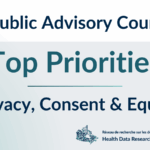Privacy, consent & equity are top priorities for HDRN Canada’s Public Advisory Council


HDRN Canada’s Public Advisory Council (PAC) has set key priorities for its work over the coming year, highlighting privacy in health data use and advancing equity through health data.
HDRN Canada created the PAC as part of its commitment to involving members of the public in decisions about health data. The 15-member council provides guidance on how best to communicate with the public, advises on organizational priorities, and responds to emerging themes and trends in health data access, use and systems. At the annual in-person PAC meeting, members reflected on their work to date and discussed where to focus their efforts next.
Our PAC reminds us who this work is ultimately for. Their insights help us ensure we are not just considering data access and use in the abstract, but that we are always making the connection between data and people. ~ Jannath Naveed
Privacy and consent emerged as a clear priority, especially given the growing influence of artificial intelligence in health care. People want straightforward answers about how their health data are collected, stored and shared, especially when it crosses borders or involves private companies, said PAC member Cris Carter. “We want to know where our information goes and who has access to it. Trust depends on transparency, and right now that is what people are looking for.”
The PAC created a plain-language glossary of health data terms to help the public better understand privacy, consent and other complex concepts related to personal health data. “We launched the glossary on social media during Health Literacy Month to introduce a range of health data terms that are critical to understand our experiences with health care providers and systems, but are not well understood,” Carter continued.
Promoting equity and justice in health data was another key theme that arose. Members emphasized both the potential for health data to reduce inequities within the health system and the risk of reinforcing them if used without adequate safeguards. “Health data can be a powerful tool for equity, but only if they are collected, stored and used with respect and accountability,” said Brian Cho, member of the PAC. Initiatives like HDRN Canada’s Inclusion, Diversity, Equity, and Accessibility (IDEA) Strategy provide guidance for the network’s role and responsibilities in advancing this work. “We are excited to contribute to HDRN Canada’s innovative work with IDEA in the health data space, including building trust with communities and respecting Indigenous data sovereignty,” Cho added.
The PAC will foreground these priorities as they engage in HDRN Canada’s long-term planning efforts. “Our PAC reminds us who this work is ultimately for. Their insights help us ensure we are not just considering data access and use in the abstract, but that we are always making the connection between data and people,” said Jannath Naveed, HDRN Canada’s Public Engagement Research Assistant.
“It’s only by keeping public perspectives front and centre that we can build health data technologies and systems that are technically strong as well as socially responsible,” commented Bill Pratt, Chair of the PAC. “By bringing diverse voices to the table, asking critical questions, and suggesting practical solutions, our PAC is working towards a future where health data are used to strengthen trust, promote equity and deliver meaningful benefits to everyone across Canada.”
